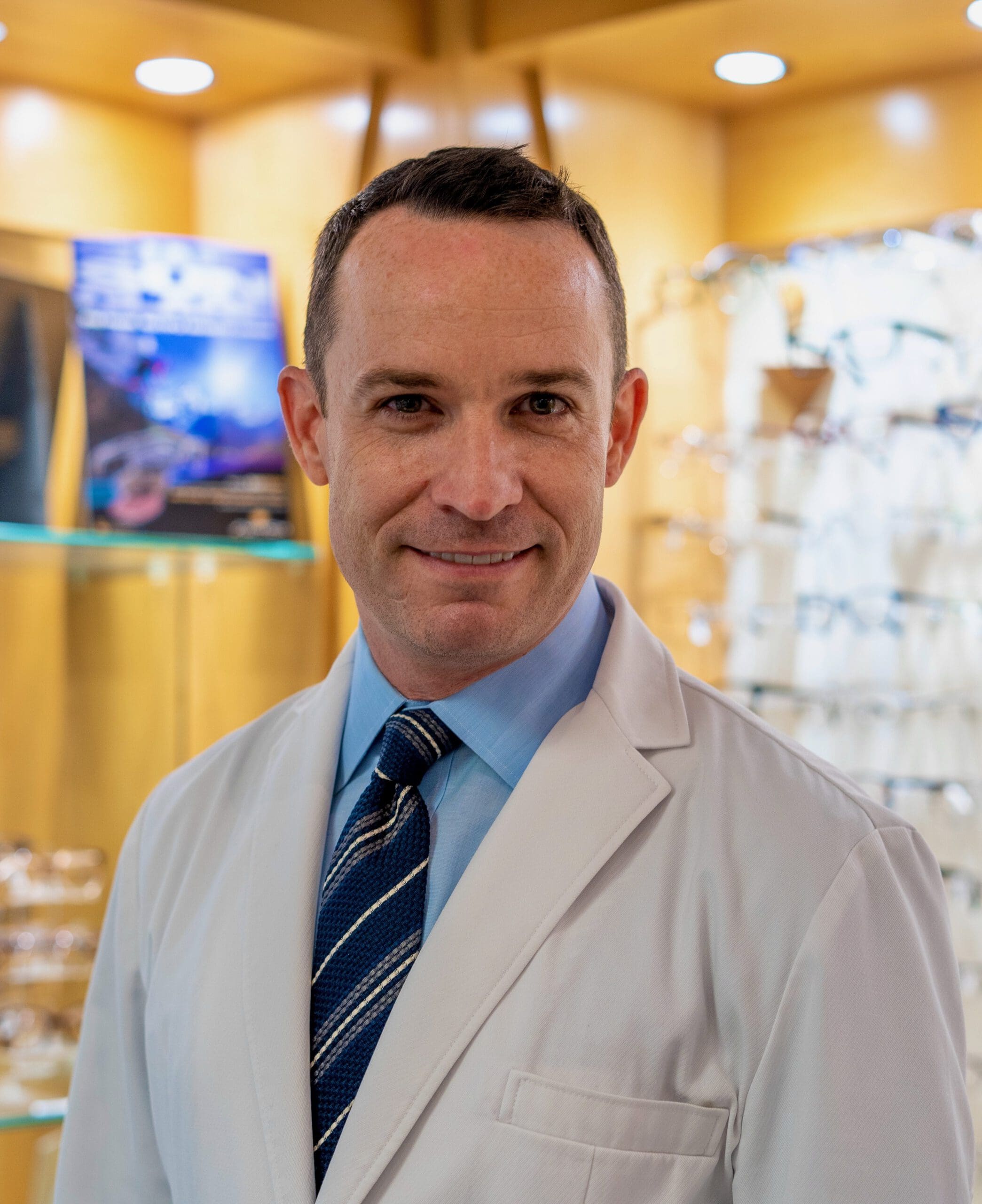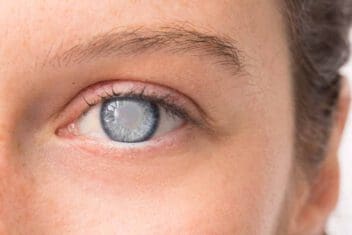
Medically Reviewed by Eric Downing, M.D. NVISION Surgeon
Signs of Cataracts: Symptoms to Watch Out For & What Cataracts Look Like
Last Updated:

Medically Reviewed by Eric Downing, M.D. NVISION Surgeon
Table of Contents
While cataracts are a progressive disease that can cause blindness when they are untreated, they are easy to diagnose and treat in the United States. After your vision is significantly obscured, you will be recommended for surgery, but this could take years after you are initially diagnosed with cataracts.

But how will you know that you have cataracts? What do they look like? There are several symptoms, but in the early stages, they may seem like several other eye conditions. You may feel like your glasses or contact lenses are constantly dirty, and you may need more light to read. You may need to wear sunglasses more often to reduce glare, or you may begin to feel unsafe driving at night. You may need much higher prescriptions for glasses or contact lenses all of a sudden. These symptoms may not be noticeable to you, but if you get regular eye checkups, your doctor will notice the problem and work to understand what is going on with your eye.
This article can help you identify and report symptoms that may be cataracts or another eye condition, so you can get the best treatment to slow the disease’s progression.
Symptoms of Cataracts Will Be Barely Noticeable in the Earliest Stages

When you develop cataracts, there are several symptoms that may appear, but in early stages, these may be irregular, mildly annoying, or mimic an existing condition like a refractive error. Most cataracts develop slowly, so the symptoms may progress in ways that you get used to easily. If you do not get regular eye exams so an optometrist or ophthalmologist can keep track of your vision changes, then you may experience serious symptoms before you get appropriate treatment.
It is important to know signs of a developing cataract, such as dizziness, and what they look like, so you can ask questions and get help from eye doctors who can diagnose your symptoms appropriately. The most reported symptoms of cataracts are detailed in the following table:
You deserve clear vision. We can help.
With 135+ locations and over 2.5 million procedures performed, our board-certified eye surgeons deliver results you can trust.
Your journey to better vision starts here.
| Symptom | Description |
|---|---|
| Blurry or hazy vision | General haze in vision or objects become blurrier, feeling like constantly dirty glasses or contacts. May seem like a progression of an existing eye condition. |
| Spots of fuzziness in vision | May feel like an inability to get glasses or contacts clean. Could obscure vision and lead to a blind spot or difficulty seeing things in certain areas of your vision. |
| Dimness requiring more light for tasks | May start needing more light for tasks, especially at dawn, dusk, or night. Using more light may not seem like a problem initially |
| Reduced intensity or yellowing of colors | Colors may seem dimmer or more yellow, as if the world is turning into a sepia-tone photograph. May not be noticeable for a long time. |
| Increased sensitivity to light | May find yourself squinting in sunlight, at overhead lights, or at the light coming from electronic devices. Initially, may result in wearing sunglasses more often. |
| Glares or halos around lights | May feel like your contact lenses are dirty or old, or you have smudges on your glasses that you cannot clean off. Progresses to difficulty seeing, especially at night. |
| Change in your refractive error | If your vision starts getting worse very quickly and you need frequent adjustment to your corrective wear, there may be an underlying cause, including a cataract. |
| Double vision in one eye | Not noticeable in early stages, especially if you are already farsighted. If you close one eye and still see double or multiple images in one eye, you likely have a problem in the lens. |
What Do Cataracts Look Like?
From a clinical perspective, cataracts present as a clouding or darkening of the eye’s natural lens. The lens sits behind the iris, the colored part of the eye, and its primary function is to focus light on the retina, which is responsible for sending visual signals to the brain. When a cataract forms, the lens becomes less transparent, leading to distorted or blurred vision.
From the outside, cataracts are not always visible to the naked eye. Early-stage cataracts might not noticeably alter the eye’s appearance. However, as cataracts progress, the following changes may be noticeable:
- Cloudy, blurry, or misty eyes: To an observer, the person’s eye might have a cloudy or milkiness to the pupil (the black center part of the eye). This effect can resemble looking through a dusty car windshield or a piece of frosted glass.
- Color changes: In advanced stages, some cataracts can cause the eye to have a brown or yellowish tint. This happens because the cataract lens discolors over time. This might not be evident in early stages, but becomes more apparent as the cataract matures.
- A noticeable halo effect: In certain light conditions, a person with cataracts may appear to have a halo or radiating light effect around their pupils. This can be particularly noticeable at night when the person’s pupils are dilated.
Remember, these signs are not always obvious, especially in the early stages. Regular comprehensive eye exams are the best way to catch cataracts and other eye conditions early. If you experience any changes in your vision, it is essential to contact an eye care professional promptly for evaluation.
You deserve clear vision. We can help.
With 135+ locations and over 2.5 million procedures performed, our board-certified eye surgeons deliver results you can trust.
Your journey to better vision starts here.
Cataract Treatment is Simple to Manage Over Time
The only way to diagnose a cataract is for an eye doctor to examine your eye, listen to your reported symptoms, and find the spot or discoloration in your lens. To diagnose a cataract, your eye doctor will dilate your pupil, so they can see the lens of your eye and then examine the area with a slit lamp and ophthalmoscope. Your doctor will also give you a visual acuity test, which usually involves reading a Snellen chart to determine how clearly you can see at what distance and how serious your refractive error is.
Once the cataract has been located, there is no way to stop the cataract from growing; however, you can make lifestyle changes to slow its progression in some cases.
- Take medications to manage chronic illnesses associated with cataract development, like diabetes.
- Quit smoking.
- Moderate how much alcohol you drink or stop drinking altogether.
- Get help ending other kinds of substance abuse.
- Eat a healthy diet full of vitamins and minerals, and take vitamin supplements if necessary.
- Get enough exercise to manage weight and blood sugar.
- Wear ultraviolet-protecting sunglasses because UV radiation damages the lens of the eye.
Your eye doctor will monitor the progress of your cataracts. They will spot when the other eye begins to develop a cataract, because this condition will occur in both eyes, and provide updates to vision correction like glasses or contact lenses to manage refractive errors caused by the cataracts as long as possible. For many people, a new prescription for glasses, including those with an antiglare coating, can help for years as the cataract’s symptoms progress. You are most likely to require vision exams once a year, although if you are younger, have an underlying health condition contributing to cataracts, or have a rapidly developing cataract, you may be in your eye doctor’s office every six months.
Cataract Surgery
While prescription glasses can help patients with cataracts maintain their vision as symptoms progress, you will still need regular eye exams to assess the development of cataracts. Ultimately, cataracts may excessively dim or cloud your lens until you cannot see clearly enough to perform your daily tasks, even when using contact lenses and glasses.
In this instance, you will need cataract surgery to remove your clouded lens and replace it with a clear artificial one that can be either a monofocal, accommodating, or multifocal intraocular lens. The surgery is pretty straightforward and takes 30 to 45 minutes.
Your cataract surgery can be done within a few hours under local anesthesia so you can go home after the procedure. However, after the operation, the doctor might place an eye patch over the treated eye and observe you for signs of bleeding or infections.
When leaving the hospital, ensure you get someone to drive you home. You will also need glasses for tasks like reading, regardless of the type of intraocular lens you receive during surgery.
You deserve clear vision. We can help.
With 135+ locations and over 2.5 million procedures performed, our board-certified eye surgeons deliver results you can trust.
Your journey to better vision starts here.
References
- Cataract. American Optometry Association (AOA).
- Facts About Cataracts. (September 2015). National Eye Institute (NEI).
- What Are Cataracts? (November 9, 2018). American Academy of Ophthalmology (AAO).
- Cataract. Prevent Blindness.
- Cataracts FAQ. Wilmer Eye Institute, Johns Hopkins University Medicine.
- Cataract surgery overview. (February 9, 2021). NHS.
- Cataract: What You Should Know. (September 2015). U.S. Department of Health and Human Services.
- Cataracts. (November 2014). University of Michigan.

Eric Downing, M.D. is an ophthalmologist and surgeon who treats Cataracts, Diabetes, Age-Related Macular Degeneration, Glaucoma, and Pterygium.
This content is for informational purposes only. It may have been reviewed by a licensed physician, but is not intended to serve as a substitute for professional medical advice. Always consult your healthcare provider with any health concerns. For more, read our Privacy Policy and Editorial Policy.
